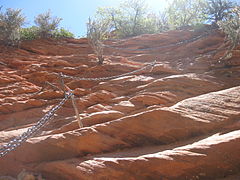Angels Landing
| Angels Landing | |
|---|---|
 Angels Landing | |
| Highest point | |
| Elevation | 5,790 ft (1,760 m) |
| Prominence | 430 ft (130 m)[1] |
| Parent peak | Cathedral Mountain (6,930 ft)[1] |
| Isolation | 0.3 mi (0.48 km)[1] |
| Coordinates | 37°16′10″N 112°56′53″W / 37.26944°N 112.94806°WCoordinates: 37°16′10″N 112°56′53″W / 37.26944°N 112.94806°W |
| Geography | |
| Topo map | USGS Temple of Sinawava |
| Geology | |
| Age of rock | Jurassic |
| Mountain type | Monolith |
| Type of rock | Navajo Sandstone |
Angels Landing, known previously as the Temple of Aeolus, is a 1,488-foot (454 m) tall rock formation[2] in Zion National Park in southwestern Utah, United States. A trail cut into solid rock in 1926 leads to the top of Angels Landing and provides views of Zion Canyon.
Trail[]
The trail to Angels Landing is 2.5 miles (4.0 km) long with an approximate 1,500 feet (460 m) elevation gain. The hike is rated as a class 3 difficulty based on the Yosemite Decimal System.[3] It begins at the Grotto drop off point on the park's shuttle system, which operates from early spring through late fall.[4] It roughly follows the path of the Virgin River for some time along the West Rim Trail, slowly gaining elevation in sandy terrain. Most of the trail is uphill on the way up to Angels Landing. As the trail gets steeper and leaves behind the river, it becomes paved. After a series of steep switchbacks, the trail goes through the area between Angels Landing and the Zion Canyon that is a gradual ascent. Walter's Wiggles, a series of 21 steep switchbacks, are the last hurdle before Scout Lookout. The wiggles are named after Walter Ruesch, who was the first superintendent for Zion National Park and constructed the switchbacks in 1926.[5]
Scout Lookout is generally the turnaround point for those who are unwilling to make the final summit push to the top of Angels Landing.[citation needed] The last half-mile of the trail is strenuous and lined with numerous sharp drop offs and narrow paths. Chains to grip are provided for portions of the last half-mile to the top at 5,790 feet (1,760 m).[6]
The half-mile section up the spine, the Angels Landing Trail-West Rim Trail, was listed in the National Register of Historic Places in 1987.[7]
Since 2000, as of March 15, 2021, 13 people have died from falling while hiking the trail.[8]
In July 2018, the trail was closed following damage due to a severe storm and was re-opened in September 2018.[9]
Climate[]
Spring and fall are the most favorable seasons to visit Angels Landing. According to the Köppen climate classification system, it is located in a Cold semi-arid climate zone, which is defined by the coldest month having an average mean temperature below 32 °F (0 °C), and at least 50% of the total annual precipitation being received during the spring and summer. This desert climate receives less than 10 inches (250 millimeters) of annual rainfall, and snowfall is generally light during the winter.[10]
Climbing Routes[]
Climbing Routes on Angels Landing include:[11]
- Prodigal Son - V class 5.7 C2 - 9 pitches
- Lowe Route - IV/V class 5.13 or 5.9 C3 - 13 pitches
- Northeast Buttress - IV class 5.10+ - 8 pitches
- South Face - II class 5.10 - 3 pitches
- Ball and Chain - V class 5.12d A0 - 9 pitches
- Angels Hair - V class 5.13a - 11 pitches
Gallery[]

Summit of Angels Landing 
Zion Canyon as seen from the summit of Angels Landing Looking toward the top of Angel's Landing
Angel's Landing trail including chain cables

Zion Canyon viewed from Angel's Landing, showing the immense vertical relief
See also[]
References[]
- ^ Jump up to: a b c "Angels Landing, Utah". Peakbagger.com.
- ^ Zion National Park eHike
- ^ "Angel's Landing: Climbing, Hiking, and Mountaineering". summitpost.org. SummitPost. Retrieved 2017-12-17.
- ^ Lloyd, Tommy. "Angels Landing Hike - Not for the Faint of Heart". mountainranges.org. mountainranges. Archived from the original on 8 December 2015. Retrieved 4 December 2015.
- ^ "Angel's Landing in Zion National Park". hikespeak.com. Hikespeak. Retrieved 2017-01-04.
- ^ Annie, Hartman (12 July 2018). "Angels Landing Is One of the Most Dangerous Hikes in the US". Curiosity: Amazing Places. curiosity.com. Retrieved 23 August 2018.
- ^ Jurale, Jim; Witherall, Nancy (1984). "National Register of Historic Places Inventory - Nomination Form: Multiple Resources for Zion National Park". National Park Service. Retrieved 2009-09-03.
- ^ "FOX 13 Investigates: Hikers pay deadly price on Zion's Angels Landing trail". 16 March 2021.
- ^ Bultrus, Aly (2018-09-21). "Angels Landing Reopens Following Storm - Zion National Park (U.S. National Park Service)". National Park Service. Archived from the original on 2018-10-01. Retrieved 2021-02-18.
- ^ "Zion National Park, Utah, USA - Monthly weather forecast and Climate data". Weather Atlas. Archived from the original on August 31, 2020. Retrieved 31 August 2020.
- ^ "Climbing Route Search". SuperTopo.com. Retrieved 12 Apr 2021.
External links[]
| Wikimedia Commons has media related to Angels Landing (Zion National Park). |
- Rock formations of Utah
- Landforms of Washington County, Utah
- Zion National Park








